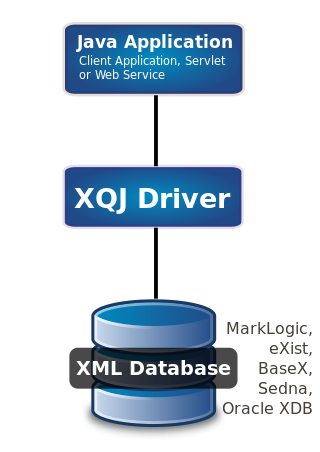This article needs additional citations for verification .(February 2024) |
In computing, Java XML APIs were developed by Sun Microsystems, consisting separate computer programming application programming interfaces (APIs). [1]
This article needs additional citations for verification .(February 2024) |
In computing, Java XML APIs were developed by Sun Microsystems, consisting separate computer programming application programming interfaces (APIs). [1]
Only the Java API for XML Processing (JAXP) is a required API in Enterprise Java Beans Specification 1.3.
A number of different open-source software packages implement these APIs:

Extensible Markup Language (XML) is a markup language and file format for storing, transmitting, and reconstructing arbitrary data. It defines a set of rules for encoding documents in a format that is both human-readable and machine-readable. The World Wide Web Consortium's XML 1.0 Specification of 1998 and several other related specifications—all of them free open standards—define XML.
XSLT is a language originally designed for transforming XML documents into other XML documents, or other formats such as HTML for web pages, plain text or XSL Formatting Objects, which may subsequently be converted to other formats, such as PDF, PostScript and PNG. Support for JSON and plain-text transformation was added in later updates to the XSLT 1.0 specification.
In computing, the Java API for XML Processing (JAXP), one of the Java XML application programming interfaces (APIs), provides the capability of validating and parsing XML documents. It has three basic parsing interfaces:
SAX is an event-driven online algorithm for lexing and parsing XML documents, with an API developed by the XML-DEV mailing list. SAX provides a mechanism for reading data from an XML document that is an alternative to that provided by the Document Object Model (DOM). Where the DOM operates on the document as a whole—building the full abstract syntax tree of an XML document for convenience of the user—SAX parsers operate on each piece of the XML document sequentially, issuing parsing events while making a single pass through the input stream.
The Java Web Services Development Pack (JWSDP) is a free software development kit (SDK) for developing Web Services, Web applications and Java applications with the newest technologies for Java.
Jakarta XML Binding is a software framework that allows Java EE developers to map Java classes to XML representations. JAXB provides two main features: the ability to marshal Java objects into XML and the inverse, i.e. to unmarshal XML back into Java objects. In other words, JAXB allows storing and retrieving data in memory in any XML format, without the need to implement a specific set of XML loading and saving routines for the program's class structure. It is similar to xsd.exe and XmlSerializer in the .NET Framework.
Saxon is an XSLT and XQuery processor created by Michael Kay and now developed and maintained by his company, Saxonica. There are open-source and also closed-source commercial versions. Versions exist for Java, JavaScript and .NET.
Apache XML is a category of projects at the Apache Software Foundation that focus on XML-related projects.
eXist-db is an open source software project for NoSQL databases built on XML technology. It is classified as both a NoSQL document-oriented database system and a native XML database. Unlike most relational database management systems (RDBMS) and NoSQL databases, eXist-db provides XQuery and XSLT as its query and application programming languages.
Jakarta XML RPC allows a Jakarta EE application to invoke a Java-based web service with a known description while still being consistent with its WSDL description. JAX-RPC is one of the Java XML programming APIs. It can be seen as Java RMIs over web services. JAX-RPC 2.0 was renamed JAX-WS 2.0. JAX-RPC 1 is deprecated with Java EE 6. The JAX-RPC service utilizes W3C standards like WSDL . The core API classes are located in the Java package javax.xml.rpc.
Streaming API for XML (StAX) is an application programming interface (API) to read and write XML documents, originating from the Java programming language community.
Jakarta SOAP with Attachments, as part of Jakarta XML Web Services (JAX-WS), provides a standard way to send XML documents over the Internet from the Jakarta EE platform.
The Jakarta XML Web Services is a Jakarta EE API for creating web services, particularly SOAP services. JAX-WS is one of the Java XML programming APIs.
Metro is a high-performance, extensible, easy-to-use web service stack. Although historically an open-source part of the GlassFish application server, it can also be used in a stand-alone configuration. Components of Metro include: JAXB RI, JAX-WS RI, SAAJ RI, StAX and WSIT. Originally available under the CDDL and GPLv2 with classpath exception, it is now available under Eclipse Distribution License
XPath is an expression language designed to support the query or transformation of XML documents. It was defined by the World Wide Web Consortium (W3C) in 1999, and can be used to compute values from the content of an XML document. Support for XPath exists in applications that support XML, such as web browsers, and many programming languages.
Jakarta RESTful Web Services, is a Jakarta EE API specification that provides support in creating web services according to the Representational State Transfer (REST) architectural pattern. JAX-RS uses annotations, introduced in Java SE 5, to simplify the development and deployment of web service clients and endpoints.
XQuery is a query and functional programming language that queries and transforms collections of structured and unstructured data, usually in the form of XML, text and with vendor-specific extensions for other data formats. The language is developed by the XML Query working group of the W3C. The work is closely coordinated with the development of XSLT by the XSL Working Group; the two groups share responsibility for XPath, which is a subset of XQuery.

XQuery API for Java (XQJ) refers to the common Java API for the W3C XQuery 1.0 specification.

An XML transformation language is a programming language designed specifically to transform an input XML document into an output document which satisfies some specific goal.